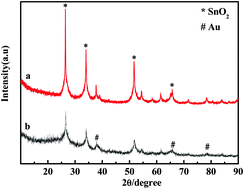Non-enzymatic sensors based on a glassy carbon electrode modified with Au nanoparticles/polyaniline/SnO2 fibrous nanocomposites for nitrite sensing
Abstract
A non-enzymatic sensor based on Au nanoparticles (AuNPs)/polyaniline (PANI)/tin oxide (SnO2) nanocomposites (Au/PANI/SnO2) was prepared for enhanced electrochemical sensing of nitrite (NO2−). The nanocomposite was designed purposely to combine the virtues of noble metal, conducting polymer and metal oxides. The obtained nanocomposite has been confirmed by a series of characterization techniques such as field emission scanning electron microscopy (FE-SEM), transmission electron microscopy (TEM), X-ray powder diffraction (XRD), Fourier transform infrared (FTIR) spectroscopy and electrochemical techniques. The results showed that a large number of AuNPs (about 5 nm) with spherical morphologies were distributed on the fibrous surface of PANI–SnO2, which made the sensor exhibit an excellent response to NO2− detection with a wide linear range of 0.25 μM to 2.4 mM, a sensitivity of 0.08314 μA μM−1 cm−2 and a low detection limit of 0.08 μM (S/N = 3). Moreover, this sensor also exhibited good selectivity, stability and repeatability. Therefore, Au/PANI/SnO2 promised to be a new platform for the electrochemical detection of NO2−.



 Please wait while we load your content...
Please wait while we load your content...